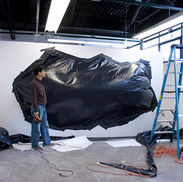商徐宏
When Night Falls
When Night Falls is a multifaceted project composed of six interrelated series, each investigating the psychological condition of contemporary humanity with varying degrees of specificity. The most general of the series examines the difficulty of focusing—visually and conceptually—and the resulting disorientation in one’s sense of self and place. At its core, the project questions how individuals locate themselves—physically, emotionally, and philosophically—within an increasingly ambiguous and fragmented world.
The viewer becomes central to this inquiry, often situated within shifting spatial cues and destabilized by intentionally ambiguous visual structures. This disorientation is heightened through distinctive approaches to material, composition, and display. For example, a band of eight paintings presented end-to-end in a horizontal sequence becomes a metaphor for the tenuous continuity of perception and identity—continuous yet disconnected.
Each component series expands this overarching investigation through its own medium and conceptual lens:
Keep Dreaming (2025) continues this exploration of fragmentation and poetic ambiguity. Using digitally altered
images layered with text, printmaking, and translucent materials, the project examines the tenuous boundary
between imagination and reality. The incorporation of
handmade kites and textual overlays suggests the struggle
to preserve wonder amid chaos, inviting viewers into a
space of suspended belief.
When Night Falls (2023), the titular multimedia installation, combines large-scale painting, handmade kites, burned black paper drawings, digitally manipulated images, and found text. Its variable dimensions and layered materials create a dynamic visual field where viewers navigate shifting symbols and references—airports, books, flight paths—echoing themes of displacement, transition, and memory.
Random (2011) deepens the project’s psychological scope by addressing estrangement from nature. Scattered, ephemeral forms evoke a lost connection to the natural world, now perceived as fragmented and conceptual rather than absolute. Ambiguous imagery invites projection while resisting closure, creating a space of unresolved longing and distance.
Moonbeam (2010) introduces historical and geopolitical dimensions, juxtaposing lunar imagery with sharp incisions and scientific markings. Referencing the space race and environmental degradation, the series reflects on how human ambition severs our bond with the cosmos, replacing wonder with control, and clarity with residue.
Sleepless Night (2021), a single-channel video, immerses
the viewer in temporal and spatial uncertainty. Through
distance, indistinctness, and ambiguity, the work reflects
on the infinite potential that exists before choice or
resolution. Inspired by Taoist philosophy, it raises questions about volition, possibility, and the limits of perception.
Up in the Air (2009), the earliest work in the project, establishes foundational themes of potential and realization. An immersive installation of drifting kites and curtained space evokes the moment before action, where all outcomes remain possible. As viewers cross thresholds and reveal obscured objects, the work meditates on the irreversible nature of choice and the melancholic beauty of suspended time.
Collectively, the six series form a cumulative inquiry into perception, dislocation, and psychological fragmentation. When Night Falls is less a narrative than a landscape of inquiry—where vision falters, meaning disperses, and the viewer is left navigating the uncertain terrain between knowing and unknowing, presence and absence, dreaming and waking.

Sleepless Tonight
Up in the Air Installation 2009






















